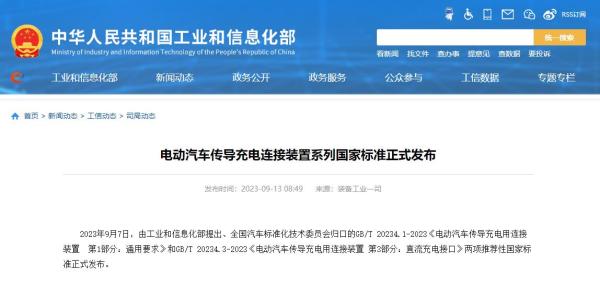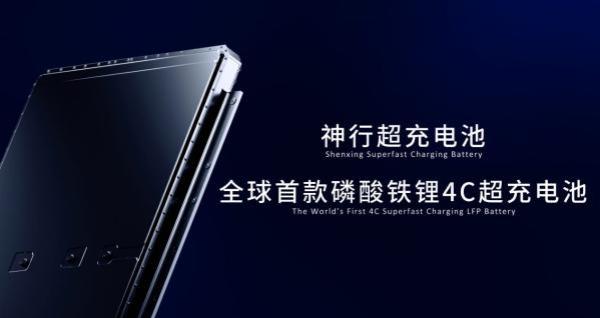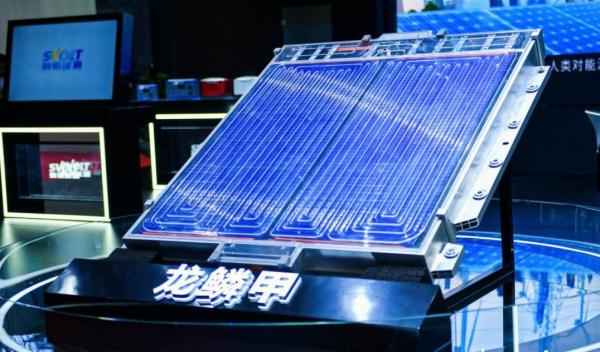On September 13th, the Ministry of Industry and Information Technology announced that recently, GB/T 20234.1-2023 "Connecting Devices for Conductive Charging of Electric Vehicles Part 1: General Requirements" and GB/T 20234.3-2023 "Connecting Devices for Conductive Charging of Electric Vehicles Part 3: DC Charging Interface" were proposed by the Ministry of Industry and Information Technology and under the jurisdiction of the National Automobile Standardization Technical Committee.

The new standard follows the current technical scheme of DC charging interface in China and ensures the universal compatibility of new and old charging interfaces. At the same time, the maximum charging current is increased from 250 amps to 800 amps and the charging power is increased to 800 kilowatts. Relevant technical requirements such as active cooling and temperature monitoring are added, and test methods such as mechanical performance, locking device and service life are optimized and improved.
The Ministry of Industry and Information Technology pointed out that the charging standard is the basis for ensuring the interconnection between electric vehicles and charging facilities and safe and reliable charging. In recent years, with the increase of driving range of electric vehicles and the increase of charging rate of power batteries, consumers’ demand for rapid replenishment of electric energy for vehicles has become increasingly strong. New technologies, new formats and new demands, such as "high-power DC charging", are constantly emerging, and it has become a general consensus in the industry to speed up the revision and improvement of the relevant standards of the original charging interface.
According to the development of electric vehicle charging technology and the demand for quick charging, the Ministry of Industry and Information Technology organized the National Automobile Standardization Technical Committee to complete two recommended revisions of national standards, which achieved a brand-new upgrade to the original 2015 version of the national standard scheme (commonly known as the "2015+" standard), which is conducive to further improving the environmental adaptability, safety and reliability of conductive charging connection devices, and at the same time meeting the actual needs of DC low-power and high-power charging.
In the next step, the Ministry of Industry and Information Technology will organize relevant units to do a good job in the promotion and implementation of the two national standards, promote the popularization and application of technologies such as high-power DC charging, and create a good environment for the high-quality development of the new energy automobile industry and the charging facility industry. Slow charging has always been the core pain point of the electric vehicle industry.
According to a report of soochow securities, the average theoretical charging rate of the hot-selling models supporting fast charging in 2021 is about 1C(C stands for the charging rate of the battery system, in popular terms, 1C charging can fully charge the battery system in 60 minutes), that is, it takes about 30 minutes to achieve 30%-80% SOC and the battery life is about 219km(NEDC standard).
In practice, most pure electric vehicles need to be charged for 40-50 minutes and can travel about 150-200km to achieve SOC of 30%-80%. If the time to enter and leave the charging station (about 10 minutes) is added, the charging time of a pure electric vehicle takes about 1 hour and it can only travel on the expressway for about 1 hour.
The popularization and application of technologies such as high-power DC charging will require further upgrading of the charging network in the future. The Ministry of Science and Technology has previously introduced that China has built a network of charging facilities with the largest number of charging equipment and the largest coverage area. Most of the newly added public charging facilities are mainly DC fast charging equipment with a capacity of more than 120kW, and 7kW AC slow charging piles in the private sector have become standard. The application of DC fast charging method has basically been popularized in the field of special vehicles, and public charging facilities have the real-time monitoring capability of cloud platform networking. APP pile finding and online payment have been widely used, and new technologies such as high-power charging, low-power DC charging, automatic charging connection and orderly charging are gradually being industrialized.
In the future, the Ministry of Science and Technology will focus on the key technologies and equipment of efficient collaborative charging and replacement, such as the key technologies of vehicle-pile-cloud interconnection, the planning method of charging facilities and orderly charging management technology, the key technologies of high-power wireless charging, and the key technologies of rapid replacement of power batteries.
On the other hand, high-power DC charging puts forward higher requirements for the performance of power battery, the key component of electric vehicles.
According to soochow securities’s analysis, firstly, the principle of increasing the charge rate of the battery is contrary to that of increasing the energy density, because high rate requires smaller particles of anode and cathode materials and high energy density requires larger particles of anode and cathode materials.
Secondly, high-rate charging in high-power state will bring more serious side effects of lithium evolution and heat generation to the battery, which will reduce the safety of the battery.
Among them, the negative electrode material of the battery is the main limiting factor for fast charging. This is because the cathode graphite is made of graphene sheet, and lithium ions enter the sheet through the edge, so the cathode quickly reaches the limit of its ability to absorb ions in the process of rapid charging, and lithium ions begin to form solid lithium on the top of graphite particles, that is, a side reaction of lithium precipitation occurs. Lithium precipitation will reduce the effective area of the negative electrode for lithium ions to be embedded. On the one hand, it will reduce the battery capacity, increase the internal resistance and shorten the life. On the other hand, the interface crystal will grow, puncture the separator and affect the safety.
Professor Wu Ningning of Rongshengmeng Guli New Energy Technology Co., Ltd. and others have previously written that in order to improve the fast charging ability of power batteries, it is necessary to improve the migration speed of lithium ions in battery cathode materials, accelerate the embedding speed of lithium ions in cathode materials, improve the ionic conductivity of electrolyte, select fast charging separators, improve the ionic and electronic conductivity of electrodes and select appropriate charging strategies.
However, what consumers can expect is that since last year, domestic battery companies have begun to exert their efforts and layout on fast charging pools. In August this year, Contemporary Amperex Technology Co., Limited, the leading company, released the 4C Shenxing rechargeable battery based on the positive Ferrous lithium phosphate system (4C means that the battery can be fully charged in a quarter of an hour), which can realize the ultra-fast charging speed of "charging for 10 minutes and cruising for 400 kilometers". At room temperature, the battery can be charged to 80%SOC in 10 minutes. At the same time, Contemporary Amperex Technology Co., Limited adopts the battery core temperature control technology on the system platform, which can quickly heat to the optimal working temperature range in low temperature environment, even in the low temperature environment of -10℃, it can be charged to 80% in 30 minutes, and it will accelerate at zero speed without attenuation in the low temperature power loss state.
According to Contemporary Amperex Technology Co., Limited, Shenxing rechargeable battery will be mass-produced this year, and it will be the first to be used in Aouita models.


And the 4C Kirin fast-charging battery based on ternary lithium cathode material in Contemporary Amperex Technology Co., Limited, after landing the ideal pure electric vehicle first this year, recently landed the Krypton luxury hunting super-run 001FR.
In addition to Contemporary Amperex Technology Co., Limited, among other domestic battery companies, Chuangxin Airlines has laid out two routes in the field of 800V high-voltage fast charging: square battery supports 4C fast charging, and large cylindrical battery supports 6C fast charging. In terms of square battery scheme, Zhongchuang Singapore Airlines provided Tucki G9 with a new generation of fast-charging lithium iron battery and medium-nickel high-voltage ternary battery based on 800V high-voltage platform, realizing SOC from 10% to 80% in 20 minutes.
Honeycomb Energy released the dragon scale battery in 2022. The battery is compatible with all chemical systems such as lithium iron, ternary and cobalt-free, covering the 1.6C-6C fast charging system, and can be mounted on A00-D series vehicles. The designated vehicles are expected to be mass-produced in the fourth quarter of 2023.

Yiwei Lithium Energy released the π system of large cylindrical battery in 2023. The "π" cooling technology of the battery can solve the problem of fast charging and heating of the battery, and its 46 series large cylindrical battery is expected to be delivered in mass production in the third quarter of 2023.
In August this year, Xinwangda Company also told investors that the "flash charging" battery launched by the company for the BEV market can be adapted to 800V high voltage and 400V normal pressure systems. Super fast charging 4C battery products have been mass-produced in the first quarter. The development of 4C-6C "flash charging" battery is progressing smoothly, and the whole scene can last 400 kilometers in 10 minutes.